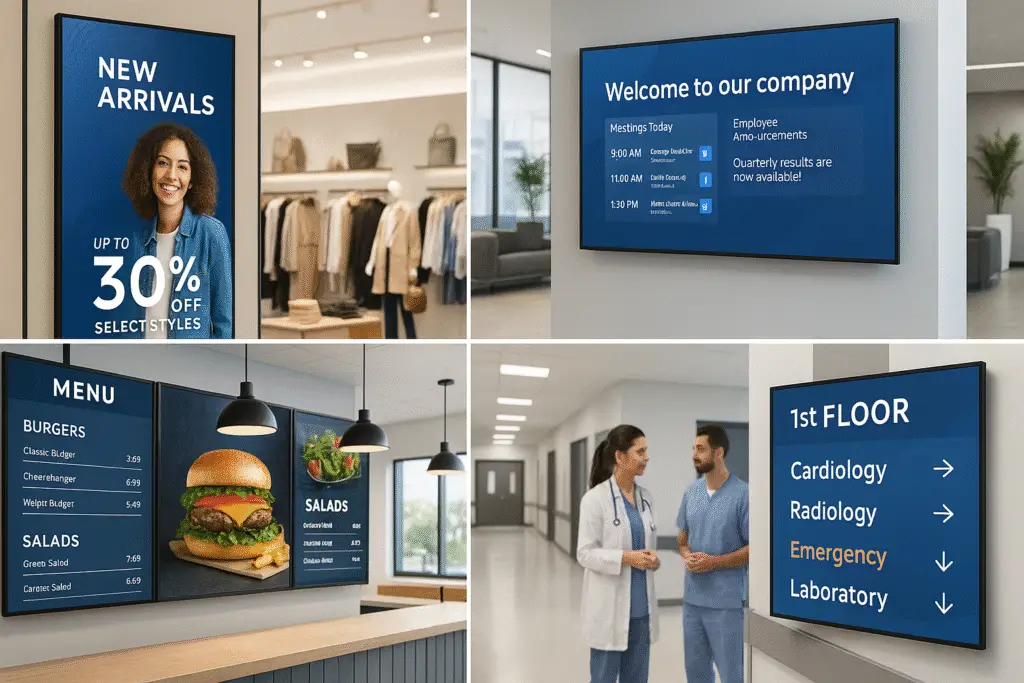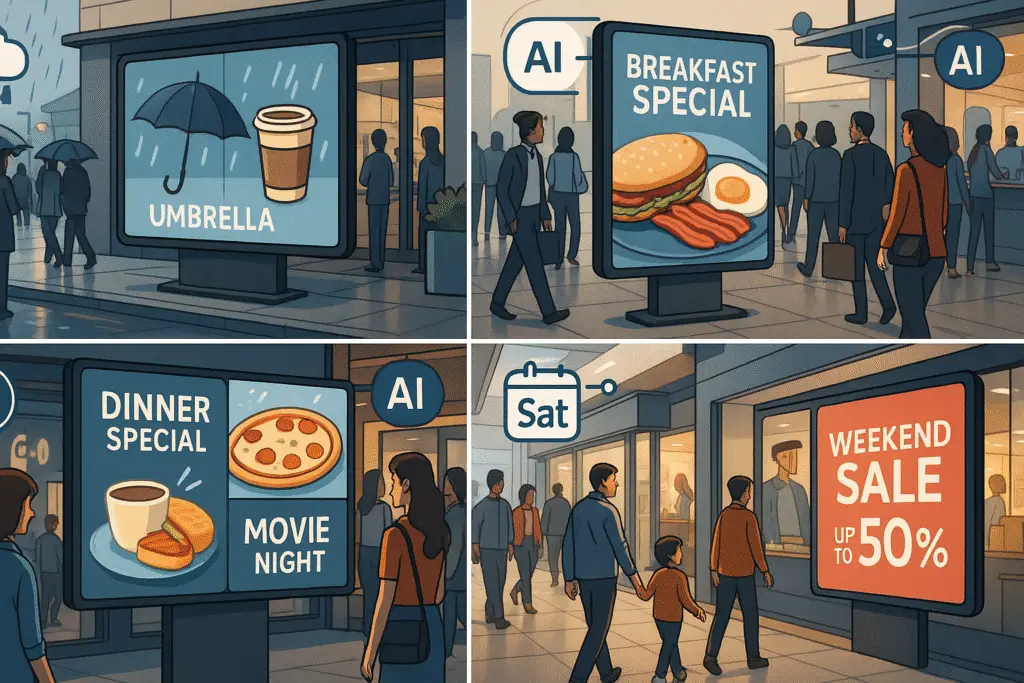Digital signage trends are all around us, and they’re getting harder to ignore. Walk into a store, stroll through a mall, or race to your gate at the airport, screens are everywhere. Each one competing for your attention. And they’re no longer just bright and flashy. They’re smart, sharp, and designed to adapt.
Heading into 2025, the game is changing fast. The latest digital signage trends aren’t just about prettier displays or crisper resolution. They’re about real-time content updates, smarter targeting, and connected systems that act more like ecosystems than standalone screens.
In this guide, I’ll break down the digital signage trends that actually matter in 2025. The ones that are practical, not flashy. The ones that will help you get real results and connect with your audience in a way that feels modern, smart, and just a little more human.
What is Digital Signage?
Before we dive into the trends, let’s get clear on what we’re actually talking about. Digital signage is what happens when screens (whether it’s a massive LED billboard, digital message board, or the digital menu board at your favorite burger joint) take the place of old-school printed signs.
Instead of printing a new poster every time you need to update something, digital signage lets you change content instantly. Think promotions, announcements, live data, even interactive touchscreens. It’s all part of the same system.
And because it runs on digital signage software, it’s smart. Digital signage solutions can change based on location, time of day, or even who’s nearby. That kind of flexibility is exactly why digital signage trends are evolving so quickly. Keeping up with the latest digital signage trends isn’t just a nice-to-have anymore. It’s how you stay relevant, competitive, and actually connect with your audience.

Top Digital Signage Trends for 2025
Interactive Digital Signage Is (Finally) Worth Touching
We’ve moved past digital signs just broadcasting information. Interactive digital signage trends are now responding, guiding, and inviting users into personalized experiences that actually work.
Touchscreens – Still the standard for interactive digital signage. From finding a store in a mall to customizing a burger at a kiosk, when it’s well-designed, it just works.
Motion Sensors – Great for hands-free interaction. Think museum exhibits or retail digital signage that lights up as someone walks by.
Virtual Try-Ons – AR-powered mirrors let you “try on” clothes, glasses, or makeup with no mess and zero awkward changing rooms.
Tap-to-Feedback Tools – Let customers quickly rate a service or vote on their favorite menu item. Real-time insights, zero friction.
Retail in action: A fashion boutique lets customers browse collections, check local inventory, and preview looks. All from a sleek, in-store digital display screen.
AI Digital Signage That Actually Thinks
AI in digital signage has moved beyond buzzword status to become one of the most impactful digital signage trends. These AI digital signage systems automate smart, relevant content delivery, so your displays can respond to real-world conditions without constant babysitting.
Contextual Content – Ice cream promos when it’s hot. Soup when it’s cold. AI-powered digital signage that adapts to weather, time, or season automatically.
Audience Sensing – Estimate age, gender, even mood or group size, then display the right message through computer vision analytics.
Real-Time Updates – Digital menu boards, prices, and promotions shift automatically with weather, stock levels, or time of day.
Micro-Targeting – One screen, multiple audience experiences. Show different content depending on who’s nearby using advanced digital signage analytics.
Coffee shop example: Digital menu boards highlight iced drinks on warm days and cozy up with lattes when temps drop. All automated through AI digital signage, no staff needed.

Ready to modernize your signage?
Mobile Integration Digital Signage Trends
One of the biggest digital signage trends this year is extending screen engagement to mobile. Public displays are now portals to personal devices, creating seamless digital signage networks.
QR Codes – Scan for discounts, menus, info, or exclusive offers from any digital display.
Proximity Alerts – Opted-in users get timely push notifications as they pass by digital signage displays.
Phone-as-Remote – Let users play games, browse products, or control a screen using their smartphone.
Save-and-Continue – Tap a screen, send the details to your phone, and finish the journey on your own time.
Theater example: Walk by a screen showing trailers, scan to buy tickets, and pick seats directly from your phone.
Cloud-Based Digital Signage Management Trends
Managing digital signage networks shouldn’t feel like chaos. Cloud-based digital signage software represents one of the most practical digital signage trends, leaning hard into smarter, more user-friendly tools.
Template Libraries – Drag-and-drop content creation with built-in brand consistency for digital signage content.
Weather-Based Logic – Digital signage displays switch messaging based on live local conditions.
One-Click Publishing – Make a change, push it live across every digital signage network location in seconds.
Scheduled Content – Set it and forget it with rules for time, date, and season across your digital signage system.
Restaurant example: A quick-serve chain rolls out new seasonal menu items to 20 digital menu board locations in less than a minute.

Location-Smart Digital Signage Trends
One of the more powerful digital signage trends in 2025? Screens that know where they are, and use that info to serve smarter, more relevant content. This is geo-aware digital signage done right.
Entry Messaging – Greet customers as they walk in, with welcome messages or promos tied to time, weather, or loyalty status on digital displays.
Contextual Info – Show flight details at the gate. Highlight nearby dining options in hotel lobbies through digital building directories. Serve what matters, when it matters.
Interactive Wayfinding – Touch-enabled digital directories that update dynamically based on time of day or event schedules.
Hyperlocal Offers – Trigger flash sales or exclusive deals based on exactly where someone is in a store or shopping center.
Mall example: A shopper strolls past a digital signage display. It pulls up the nearest deals and lights up a map showing where to go. No app, no guesswork.
Digital Signage Analytics That Actually Matter
It’s not enough to put content on digital signage screens. You need to know what’s working with proper digital signage analytics. This is where measurement tools become mission-critical among current digital signage trends.
Viewer Analytics – Track how many people saw your digital signage content and how they interacted with it.
Dwell Time – See how long people actually stop and watch digital displays. More time means more impact.
Demographic Insights – Understand your audience with anonymous data on age range, gender, and group size through computer vision analytics.
Attribution Tools – Connect digital signage screen views to real-world behavior, like purchases or in-store visits.
Retail example: A brand discovers that video content on digital signage displays triples engagement compared to static images, leading them to overhaul their digital signage strategy across every location.
Sustainable Digital Signage Trends
Sustainable digital signage is no longer just a bonus among digital signage trends, it’s becoming the baseline. With rising energy costs and growing environmental awareness, businesses are prioritizing eco-friendly digital signage solutions.
Low-Power Digital Displays – LED and ePaper options dramatically cut energy use without sacrificing impact for digital signage networks.
Solar-Powered Digital Signage – Ideal for outdoor digital signage where power access is limited or unreliable.
Durable Hardware – Built to last, reducing waste and the need for frequent digital signage display replacements.
Recycling Programs – Many digital signage vendors now offer end-of-life take-back services to responsibly recycle old signage hardware.
Outdoor mall example: Solar-powered digital signage runs day and night without drawing from the grid. Saving energy and showcasing sustainability in action.

Industry-Specific Digital Signage Trends
Retail Digital Signage Trends
Retail digital signage environments are pioneering many cutting-edge digital signage trends, driven by competitive pressure and the need to create engaging shopping experiences.
In-Store Digital Marketing Screens – Retail digital signage has evolved beyond simple product advertisements to include interactive product finders, inventory status displays, and personalized recommendation engines.
Digital Price Tags – Electronic shelf labels connected to inventory systems enable real-time price updates through advanced digital signage software.
Social Proof Displays – Real-time customer reviews and social media content displayed on retail digital signage builds trust and encourages purchases.
Restaurant Digital Signage Trends
Digital menu boards and restaurant digital signage have become standard in the food service industry, but the latest digital signage trends go far beyond simple menu displays.
Dynamic Menu Pricing – Digital menu boards can adjust prices based on ingredient costs, demand patterns, or competitor pricing through intelligent digital signage systems.
Kitchen Display Integration – Restaurant digital signage connected to kitchen management systems can display order status and estimated wait times.
Multilingual Menu Support – Digital menu boards instantly switch between languages based on customer selection, improving accessibility.
Corporate Digital Signage Trends
Corporate digital signage has evolved from simple announcements to sophisticated internal communication platforms that engage employees through advanced digital signage solutions.
Employee Recognition Systems – Digital displays showcase employee achievements and performance metrics, boosting morale through engaging digital signage content.
Real-Time Business Dashboards – Corporate digital signage displays key performance indicators and operational data, keeping teams informed.
Emergency Communication Systems – Integrated alert systems can override regular content to display critical safety information across all digital signage networks simultaneously.
Getting Started with The Latest Digital Signage Trends
If you’re ready to move from idea to action with the latest digital signage trends, here’s a simple roadmap to get going, minus the overwhelm.
Set Clear Goals – What do you want your digital signage to actually do? Drive sales, improve navigation, reduce wait times, or boost engagement with interactive digital signage?
Choose the Right Digital Signage Hardware – Pick digital signage displays that fit your environment, audience, and budget. Whether it’s high-brightness outdoor digital signage or compact tablets for countertops.
Pick User-Friendly Digital Signage Software – Your content management system should be easy to update, schedule, and scale across digital signage networks. Bonus points for cloud-based digital signage platforms.
Create Engaging Digital Signage Content – Design visuals that grab attention quickly. Use motion, clear messaging, and brand consistency to make your digital displays pop.
Measure with Digital Signage Analytics – Use built-in analytics to track impressions, engagement, and sales impact. Adjust your digital signage strategy based on what’s actually working.
Stay Ahead of Digital Signage Trends – Digital signage trends evolve fast. Subscribe to updates, attend webinars, and keep testing new digital signage solutions so your strategy doesn’t get stale.
Conclusions
What started as a flashy way to grab attention has become something smarter. Today’s digital signage trends are all about connection, context, and results. From interactive digital signage to AI-powered content, digital signage is transforming into a real-time communication platform that works automatically.
The latest digital signage trends aren’t future concepts. They’re active, in-market, and already changing how brands connect with people through everything from retail digital signage to restaurant digital menu boards.
Whether you’re managing one digital display or hundreds across a digital signage network, smart digital signage solutions give you an edge. The key is implementing digital signage trends that align with your goals and actually deliver measurable results.
Ready to turn these digital signage trends into real business impact? A seasoned digital signage consultant can help you build a strategy that delivers results, without blowing your budget or burning out your team.
Learn more in my full Digital Signage Trends insights archive
FAQ
How is AI transforming digital signage in 2024?
AI is revolutionizing digital signage by enabling personalized, data-driven content. With AI, businesses can use predictive content and behavioral targeting to deliver relevant messages based on customer demographics and behaviors. AI also powers intelligent analytics to track engagement and optimize content, and automates scheduling to adapt signage in real-time to external factors like weather or time of day.
What are the benefits of integrating mobile devices with digital signage?
Mobile integration enhances the customer experience by creating seamless interactions between digital signage and smartphones. Features like personalized push notifications, QR code interactions for instant access to information, and advanced mobile control let customers engage with signage directly. This connection helps drive immediate actions, such as making purchases or redeeming promotions, while providing businesses valuable behavioral insights.
Why is sustainability a growing trend in digital signage?
Sustainability is becoming a priority as businesses seek eco-friendly signage solutions. Energy-efficient displays, such as LED and solar-powered units, help reduce environmental impact, while providers are focusing on using sustainable materials and offering recycling programs for outdated signage equipment. This trend aligns with growing consumer demand for environmentally responsible business practices.


